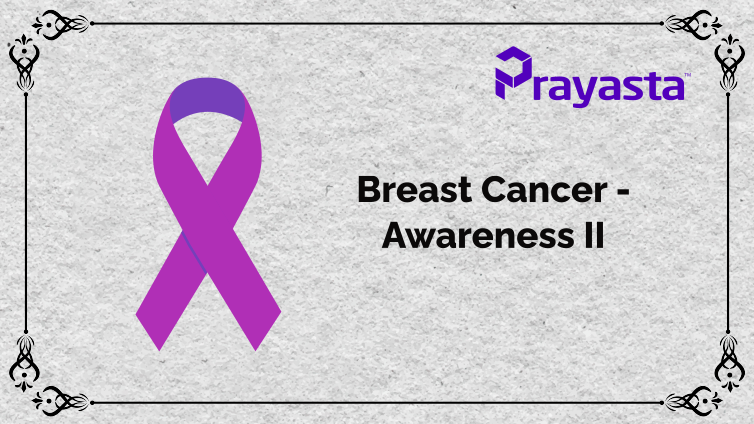Dr Ajay Sharma emphasises that self-breast exam is one of the first preventive steps to suspect a possible breast cancer- understand the sign as prevention is better than cure. Read more.
What do I do if I find a lump in my breast? Is it breast cancer for certain?
Once a person feels there is some abnormal growth of breast or any signs (refer to awareness 1) a self- breast exam (SBE) can be undertaken. A link to how to perform an SBE and general info on Breast cancer is available in Hindi (source-cancerindia.org)
So, what are the types of breast cancer? Why is it important?
Parts of the breast where cancer begins include:
The cancer occurring in the milk ducts (ductal carcinoma) is the most common type of all the breast cancer. Basically, these are channels or ducts through which milk is transported from the lobules (a bunch like structure which produces milk) to the nipple. The cancer happens in the ducts.
* Furthermore, the ductal carcinoma can be confined to local area- non-invasive (ductal carcinoma in-situ) or can spread out of the ducts (invasive ductal carcinoma).
* Lobular carcinoma- The milk producing lobules can turn out to be cancerous without spread. However, if the lobular carcinoma spreads it is known as invasive lobular carcinoma. The lobules are connected to the ducts, which carry breast milk to the nipple.
* Connective tissues. It’s quite rare to see that the tissues which help in connecting the different components of the breast (muscles, fat and blood vessels) can become cancerous. Then the term used to describe it is called Phyllodes and Agiosarcoma (arising from blood vessels).
The type of tissue where your breast cancer arises determines how the cancer behaves and what treatments are most effective.
What does the cells look like?
The pathologist views the sample of breast tissue under a microscope. This helps to differentiate the type of cancer cells that make up breast cancer and aids to prognosticate (predicts course of disease) or plan therapies and planning.
* Cancer cells with unique appearances. Some subtypes of breast cancer are named for the way they appear under the microscope. Subtypes include tubular, mucinous, medullary and papillary. Your subtype gives your doctor some clues about your prognosis and how your cells may respond to treatment.
The degree of difference between the cancer cells and normal cells is called Grade.
How different your cancer cells look from normal cells is called your cancer’s grade.
Grade 3 cancers being the most different looking and considered the most aggressive with grade 1 being less aggressive (as the cells look similar to what the local cells should look like)..
Do hormone sensitivity determine treatment of breast cancer too?
Breast cancer cells have receptors (imagine the aerobridge of an airport terminal, where the airplane can dock and passengers can exit to the terminal) outside on their walls that can catch particular hormones circulating throughout the body. Specifically, estrogen and progesterone, the two naturally occurring hormones in women, can bind (provided there are receptors) and influence the growth of cancer cells. Knowing if breast cancer is sensitive to hormones gives the doctor a better idea of how best to treat the cancer or prevent cancer from recurring.
Hormone status of breast cancers includes:
* Estrogen receptor (ER) positive: breast cancer has receptors sensitive for estrogen that allow them to use and cancer cells can grow. Treatment with anti-estrogen hormone (endocrine) therapy can block the growth of the cancer cells.
* Progesterone receptor (PR) positive: this type of breast cancer is sensitive to progesterone, and the cells have receptors that allow them to use this hormone to grow. Treatment with endocrine therapy blocks the growth of the cancer cells.
* Hormone receptor (HR) negative: this type of cancer doesn’t have hormone receptors, so it won’t be affected by endocrine treatments aimed at blocking hormones in the body.
Breast cancer awareness 2 in nutshell
* Self-breast exam is one of the first preventive steps to suspect a possible breast cancer- understand the signs! – watch the educational video. The doctor helps to decide what needs to be done if breast cancer is suspected – so don’t hesitate to seek help.
* Imaging procedures like mammogram can help in detecting cancer early, so don’t postpone when indicated.
* Biopsy helps to determine the type of cancer and provides information to plan treatment
Some breast cancers are confined to local areas and some can spread.
* Some are hormone sensitive and some are not.
I cannot emphasise enough; prevention is better than cure. Prevention happens at every level; so, when in doubt get clarification. However, the first step starts with YOU.
ABOUT THE AUTHOR

An Emergency Medicine Physician – Scientist – Author, has over 2 decades of professional experience in multi-cultural environment offering a holistic approach to health care issues. He provides services related to medical device development, validation, mentoring and reporting. Passionate about evidence –based approach to health care, health tech., education, preventive care and food.



Very informative good read …